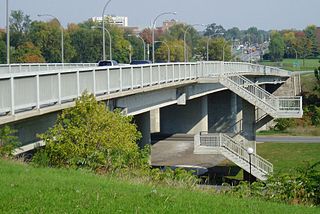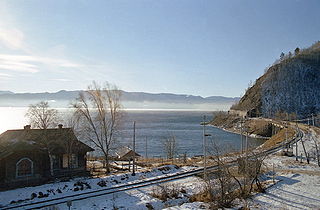
Yekaterinburg is a city and the administrative centre of Sverdlovsk Oblast and the Ural Federal District, Russia. The city is located on the Iset River between the Volga-Ural region and Siberia, with a population of roughly 1.5 million residents, up to 2.2 million residents in the urban agglomeration. Yekaterinburg is the fourth-largest city in Russia, the largest city in the Ural Federal District, and one of Russia's main cultural and industrial centres. Yekaterinburg has been dubbed the "Third capital of Russia", as it is ranked third by the size of its economy, culture, transportation and tourism.

A tunnel is an underground or undersea passageway. It is dug through surrounding soil, earth or rock, or laid under water, and is usually completely enclosed except for the two portals common at each end, though there may be access and ventilation openings at various points along the length. A pipeline differs significantly from a tunnel, though some recent tunnels have used immersed tube construction techniques rather than traditional tunnel boring methods.

The San Francisco–Oakland Bay Bridge, commonly referred to as the Bay Bridge, is a complex of bridges spanning San Francisco Bay in California. As part of Interstate 80 and the direct road between San Francisco and Oakland, it carries about 260,000 vehicles a day on its two decks. It includes one of the longest bridge spans in the United States.

The William Jolly Bridge is a heritage-listed road bridge over the Brisbane River between North Quay in the Brisbane central business district and Grey Street in South Brisbane, within City of Brisbane, Queensland, Australia. It was designed by Harding Frew and built from 1928 to 1932 by MR Hornibrook.

The Quebec Bridge is a road, rail, and pedestrian bridge across the lower Saint Lawrence River between Sainte-Foy and Lévis, in Quebec, Canada. The project failed twice during its construction, in 1907 and 1916, at the cost of 88 lives and additional people injured. The bridge eventually opened in 1919.

The Heron Road Workers Memorial Bridge is a bridge in Ottawa, Ontario, Canada. It connects Baseline Road to Heron Road and allows east–west traffic to cross both the Rideau River and the Rideau Canal just south of Carleton University. The current bridge was finished in 1967, one year after a bridge collapse killed nine workers and injured over sixty others in the worst construction accident in both Ottawa and Ontario history. It was renamed in 2016 to commemorate the victims of that accident.

The I-35W Mississippi River bridge was an eight-lane, steel truss arch bridge that carried Interstate 35W across the Mississippi River one-half mile downstream from the Saint Anthony Falls in Minneapolis, Minnesota, United States. The bridge opened in 1967, and was Minnesota's third busiest, carrying 140,000 vehicles daily. After only 39 years in service, it experienced a catastrophic failure during the evening rush hour on August 1, 2007, killing 13 people and injuring 145. The National Transportation Safety Board (NTSB) cited a design flaw as the likely cause of the collapse, noting that an excessively thin gusset plate ripped along a line of rivets. Additional weight on the bridge at the time of failure was also cited by the NTSB as a contributing factor.

The Medway Viaducts are three bridges or viaducts that cross the River Medway between Cuxton and Borstal in north Kent, England. The two road bridges carry the M2 motorway carriageways. The other viaduct carries the High Speed 1 railway line linking London and the Channel Tunnel. All three bridges pass over the Medway Valley Line.

The Brownsville & Matamoros International Bridge, also known as B&M International Bridge, and Express Bridge, is one of three international bridges that cross the U.S.-Mexico border between the cities of Brownsville, Texas, and Matamoros, Tamaulipas. This international bridge unites the Matamoros–Brownsville Metropolitan Area, which counts with a population of 1,136,995, making it the 4th largest metropolitan area in the Mexico-US border.

The Hillsborough River Bridge is a bridge crossing the Hillsborough River estuary between Charlottetown and Stratford in Queens County, Prince Edward Island. The current road bridge, built in 1962, replaced a 1905 rail bridge crossing the same span which was known by the same name.

The Circum–Baikal railway is a historical railway in the Irkutsk region of Russia. It runs along the Northern shore of the Southern extremity of Lake Baikal from the town of Slyudyanka to the Baikal settlement. Until the middle of the 20th century the Circum–Baikal railway was part of the main line of Trans–Siberian Railway; later on, however, a duplicate section of the railway was built. Sometimes called a unique achievement in engineering, the Circum–Baikal is one of the picturesque sights of the area around Lake Baikal.

The Crimean Bridge, also called Kerch Strait Bridge or Kerch Bridge, is a pair of parallel bridges, one for a four-lane road and one for a double-track railway, spanning the Kerch Strait between the Taman Peninsula of Krasnodar Krai in Russia and the Kerch Peninsula of Crimea. Built by the Russian Federation after its annexation of Crimea at the start of 2014, the bridge cost ₽227.92 billion (US$3.7 billion) and has a length of 19 km (12 mi), making it the longest bridge in Europe and the longest bridge ever constructed by Russia.

The 1994 Iranian Air Force C-130 shootdown occurred on March 17, 1994, when an Iranian Air Force C-130E military transport aircraft, carrying Iranian embassy personnel from Moscow to Tehran, was shot down by Armenian military forces near the city of Stepanakert in Nagorno-Karabakh, an area which had been under armed conflict since 1988. The 32 people on board were killed in the crash.
Rajin station is a railway station in Rajin-guyŏk, Rasŏn Special City, North Korea. It is the junction point and terminus of both the Hambuk and P'yŏngra lines of the Korean State Railway. It is also the starting point of a freight-only branchline to Rajin Port station.

Mashinostroiteley is a station of the Yekaterinburg Metro which was opened on 27 April 1991. It is situated between stations Uralmash and Uralskaya.

Botanicheskaya is a station of the Yekaterinburg Metro which was opened on November 28, 2011. The station is unique because the roof design is based on honeycombs representing the city's botanical gardens. It is also named after the nearby Botanical Garden of the Ural Branch of the Russian Academy of Sciences and the adjacent Botanichesky residential area.

The Naro-Fominsk rail crash occurred on 20 May 2014 when a freight train derailed near Naro-Fominsk, Moscow Oblast, Russia. The train was run into by a passenger train. Nine people were killed and 51 were injured.

Tumangang station is a railway station in Tumangang-rodongjagu, Sŏnbong, Rasŏn Special City, North Korea, on the Hongŭi Line of the Korean State Railway.
Hongŭi station is a railway station in Hongŭi-ri, Sŏnbong, Rasŏn Special City, North Korea; it is the junction point of the Hongŭi and Hambuk lines of the Korean State Railway.

2022 Crimean Bridge explosion was an event during the Russian invasion of Ukraine, on 8 October 2022, at 6:07 a.m., when a fire broke out on the Crimean Bridge as a result of an explosion of a bomb loaded onto a truck, which occurred on the road bridge, on the westbound vehicle lanes running from Russia to Kerch in Russian-occupied Crimea. Two two-lane vehicular spans of the bridge collapsed into the water. Two adjacent eastbound lanes on a separate structure survived. The railway bridge was also damaged by a railway tanker car that caught fire. Five people were killed. Following the incident, the Investigative Committee of Russia launched an investigation.

















